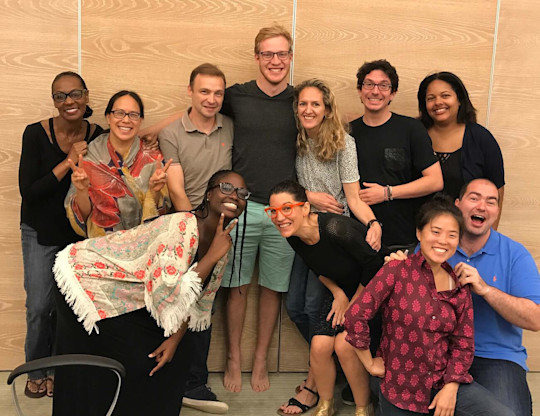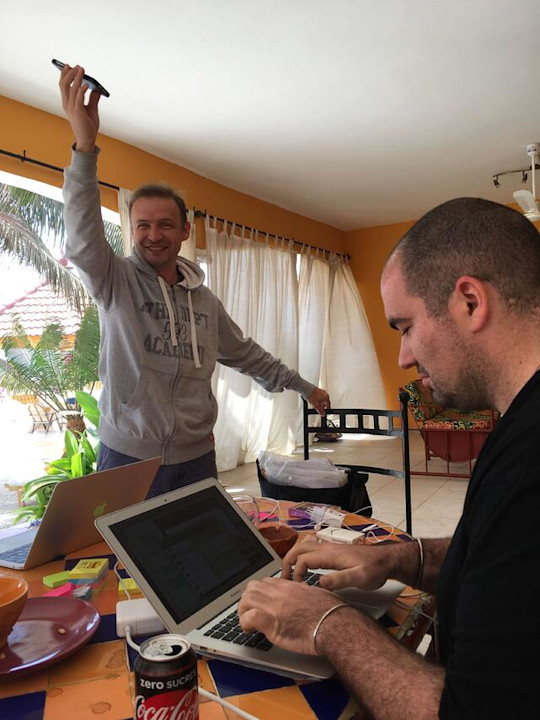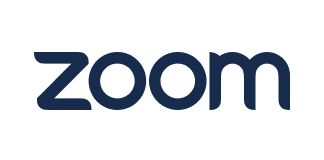UNICEF + Trello
Helping Others When They Need It Most
Industry
Non-profit
% of company using Trello
100% GIC, 70% Office of Innovation
Company Personality
Trustworthy, Innovative
Trello users since:
2014
During Hurricane Irma, over 22,000 people received life-saving information in under 30 hours thanks to UNICEF.
Using a youth engagement and communication platform called U-Report, the UNICEF Global Innovation Centre enabled hundreds of communities to prepare ahead of the disastrous storms.
Working around the clock from Bangkok to Copenhagen, Panama to Santiago, 3 of the 17 globally-distributed team members reached 14 affected countries by scaling and using U-Report in record time. More than half the people they assisted noted that this was the only timely information they received for how to prepare and keep their communities safe.
Trello was a tool that allowed UNICEF’s innovation team rapid response to the emergency.
The transparency and multiple perspectives in Trello helps us provide coherent support to a single country in which there may be multiple projects in different areas involving and supported by different people.
The short, sharp, simple messages shared with those living in the path of the storm helped to keep them and their families safe. When asked, 89% said they found the information useful, 80% had shared the information with at least one person, with 57% sharing the messages with five or more people.
For Every Child
When you think of a 70-year-old organization, you might think of an institution that’s bureaucratic and staid, but UNICEF does not fit that mold. They’ve retained the kind of trust and solidity that comes with helping children in crisis for nearly a century, but they also have innovation in their DNA. Behind each development and humanitarian effort is a driving will to make a difference differently, to deliver services better each time, and to learn from the results.
Whether that means hand pumps for faster access to clean drinking water, or processes for accurately assessing severely malnourished children, or pushing the boundaries of emerging technologies to improve their process—the mission to build a better world for every child runs through every team at UNICEF.
When it comes to pushing boundaries, the team behind UNICEF’s Global Innovation Centre (GIC) is particularly innovative. They evaluate and implement ideas and technologies that can scale at a national or multinational level for improving the lives of children and their families more efficiently and accurately. They are also exploring what it means to be a truly distributed team enabled by technology.

Imagine meeting your colleagues for the first time in years! Here, Tanya (second from left) and 10 GIC members met up in Amman, Jordan. Although rare, team offsites can be great for building relationships and esprit de corps.
Tanya Accone, Senior Advisor on Innovation who leads UNICEF’s GIC team, works with her 16 full- and part-time colleagues across 11 locations, enabling a 24-hour cycle of time zone support and asynchronous collaboration. Especially in the case of applying solutions to support emergency response, they need to conduct their work as adeptly as possible:
We can’t waste time sending things over email and later trying to find those emails, figuring out where to pick up tasks in the relay of workdays when it comes to life-saving, life-impacting information for communities. Trello helps our conversations and execution be seamless and efficient.
In 2016, this small team of extreme remote workers actively worked with 89 of the 193 countries UNICEF supports, to launch new initiatives with governments and organizations, helping them to prepare for disruptive events and introducing new ways of working that accelerate health, protection, and education initiatives for children supported by UNICEF and its partners around the world.
Pushing Remote Work To The Extreme
The GIC team was initially co-located as a small team of seven working in Kampala, Uganda. They began using Trello as a means to have all their most important information stored in one place—a single source of truth that gave the whole team a level of transparency unavailable in unwieldy email threads and documents on local computers.
Trello helps our team organize our internal efforts so that we can be the most effective at supporting others whether in times of crisis or during regular work to address social needs.
Driven by demand for support from countries, the team soon outgrew what could be effectively delivered via a single location model. The team became nomadic, with members traveling to support different country offices around the world. When they decided to distribute the team across the globe to enhance effectiveness and efficiency, that single source of truth became even more valuable. They pushed remote work to its most extreme limits with a 24-hour asynchronous work day, unearthing the need for a suite of tools to collaborate, organize, and share a single perspective on their efforts regardless of longitude or latitude.

Global coordination calls with 40+ countries at a time happen regularly and are run from wherever the hosting team member finds themselves. Adding to the challenge? Finding cell service when there is limited connectivity!
The goal was to build a new virtual workspace that enabled them to act as efficiently and connected across nine time zones as they were when they were co-located. And so, in 2016, as part of their mission to bring innovation to the way UNICEF works, they kicked off a systematic exploration of a range of different team collaboration tools to find the ideal “extreme remote work” tech stack.
Selecting Trello (Again)
Over a 12 month period, Tanya’s team assessed and tested 17 different collaboration apps across areas of project management, video, chat, and email. As part of the experiment, they ran workflows in four different project collaboration tools.
In the end, they settled on a suite of five tools to run their virtual office. Notwithstanding their previous use of Trello, it again emerged as their top team collaboration choice for some important reasons:
- The simple board-list-card structure was easy to adopt by team members who didn’t have project management training;
- Its flexible and transparent nature means everyone can access the information they need;
- New workflows can be invented as needed, and boards can be used for more than just tracking tasks;
- The visual perspective, combined with features like labels and filtering, helps them look at information in different (and valuable) combinations, whether by country or globally by effort or solution.
We are able to mold and shape Trello to the way our organization thinks and behaves, rather than trying to fit our team and our needs, which are changing everyday, into a set structure.
How Trello Helps Provide A Global Perspective
For the UNICEF GIC team, Trello is their most important internal coordination tool—a collaborative foundation for the work they do.
Working with any number of countries at any given time, they are able to keep track of every location, including all points of contact and every important document, on dedicated Trello boards.

Often spearheading multiple initiatives at once within the same country, they then organize board names by country and by solution they’re helping to scale. During the Caribbean hurricane crises, they focused on a board for “Urgent Irma Response” all the while keeping their other local information in view.
In the back of our minds, we also knew all the other conversations we were having with those 14 countries about implementing anything else that may have been relevant, and who the key contacts and focal points were in each country.
At the same time, in other parts of the world, their team works on initiatives like UPSHIFT, an incubator program to build youth entrepreneurship and social innovation. This program supports the most marginalized youth, including those with disabilities and those who are displaced, in 8 different countries and regions to develop as entrepreneurs and solution builders in their communities. The core work to manage these 8 projects and the 20 countries who want to introduce UPSHIFT (which have both similar components and different ecosystems and stages of development at any one time) is done in Trello.
But Trello is just part of the journey.
The output from the high level of perspective that Trello provides is brought to life in the experiences that programs like UPSHIFT provide, like that of Tuấn Nguyễn, a visually impaired university student in Vietnam who is now supporting an entire community of professionals like himself with online job boards.
Or Rina Shabani, a 16 year-old Kosovan teenager who is now leading the charge on gender inequality education among her peers. Social innovators in Kosovo like Rina, have launched solutions that have helped more than 200,000 people.
The GIC is also supporting UNICEF Indonesia and the Government of Indonesia to manage their largest-ever immunization campaign, a push to vaccinate 70 million children against life-threatening Measles and Rubella viruses.
Again, technology is the foundation for making this kind of change at scale: RapidPro, an open source communication tool, provides actionable insights in real time that the traditional paper-based tracking system cannot, and it reaches people on their own mobile phones; in this case over SMS. Lessons learned from deployments in Indonesia and also in Zambia will be applied in countries interested in applications of RapidPro to support their immunization goals.
With just two people building out the RapidPro process to support digital health in 15 countries, the collaborative foundation in Trello helps them keep that work transparent so team members can self-serve on details they need without having to stop and give updates constantly. This also allows the team to form part of—and amplify—a network of health experts who can drive this work across UNICEF.
Improving the Lives of Children: From Now To The Future
At its core, the mission behind UNICEF’s Global Innovation Centre is to take an idea that helps thousands of people in one place and deploy it to help millions of children and their families across the approximate 190 countries across the globe where UNICEF works.
In practice, that means Tanya’s team is committed to open source principles and digital innovation. In other words, UNICEF projects are built to be shared and used by others, not just via their organization. Trello shares this spirit of productive, evolving collaboration and that’s why it’s been the ideal vehicle for enabling this work.
We build everything so that it can be easily set up, used, adapted and replicated because we always keep in our minds who these tools help: children and their families in the most hard-to-reach places.
As Tanya notes, from the highest level of humanitarian teamwork down to tools they use like Trello, we’re all part of a larger, shared ecosystem that is affected by the efforts we make to help others. And those efforts are most impactful when they evolve and grow with the needs of the communities they serve:
We aim to be enzymes as opposed to catalysts. Catalysts make chemical reactions happen faster. Enzymes increase the rate of change even faster than catalysts, they convert what they act on into something new, and enzymes themselves are changed and evolve as a result of that process.
Overall this means that the GIC portfolio of projects, like the Trello boards they use to track them, will look very different in a year’s time. And that’s a very good thing.
We’d like to look back and see that we’ve had a hand in scaling massive positive results with and for children. We’d like to take things that are ‘innovative’ and turn them into how work is done across the board. Overall, we hope to evolve with the next best way to introduce beneficial change in the world.
Join over 2,000,000 teams worldwide who are using Trello to get more done.
NOW AVAILABLE
A 14 Day Free Trial of Premium!
Get unlimited boards, Trello views, and limitless automation, plus a ton more.
